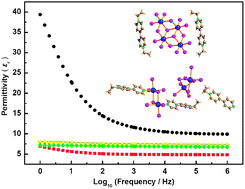Iodobismuthates with N-alkyl- or N,N′-dialkyl-4,4′-bipyridinium: syntheses, structures and dielectric properties†
Abstract
The solvothermal reactions of BiI3, KI, I2,

* Corresponding authors
a
College of Chemistry, Chemical Engineering and Materials Science, Soochow University, Suzhou 215123, Jiangsu, P. R. China
E-mail:
jplang@suda.edu.cn
Fax: 86-512-65880089
b State Key Laboratory of Coordination Chemistry, Nanjing University, Nanjing 210093, P. R. China
The solvothermal reactions of BiI3, KI, I2,

 Please wait while we load your content...
Something went wrong. Try again?
Please wait while we load your content...
Something went wrong. Try again?
Y. Chen, Z. Yang, X. Wu, C. Ni, Z. Ren, H. Wang and J. Lang, Phys. Chem. Chem. Phys., 2011, 13, 5659 DOI: 10.1039/C0CP02431G
To request permission to reproduce material from this article, please go to the Copyright Clearance Center request page.
If you are an author contributing to an RSC publication, you do not need to request permission provided correct acknowledgement is given.
If you are the author of this article, you do not need to request permission to reproduce figures and diagrams provided correct acknowledgement is given. If you want to reproduce the whole article in a third-party publication (excluding your thesis/dissertation for which permission is not required) please go to the Copyright Clearance Center request page.
Read more about how to correctly acknowledge RSC content.
 Fetching data from CrossRef.
Fetching data from CrossRef.
This may take some time to load.
Loading related content
